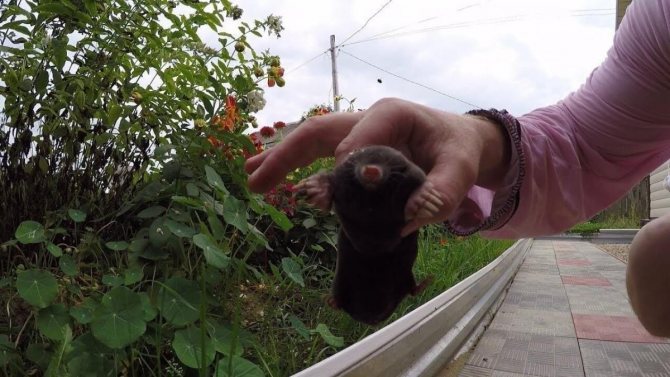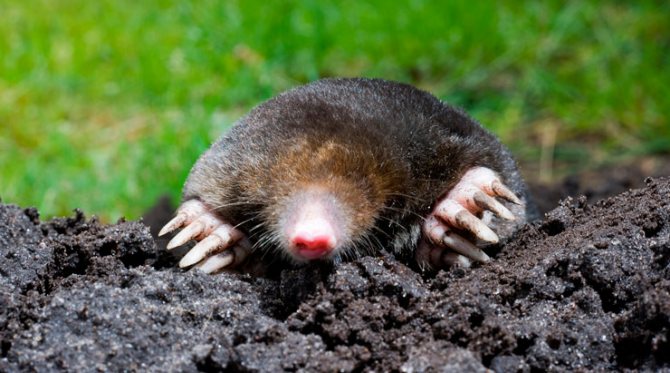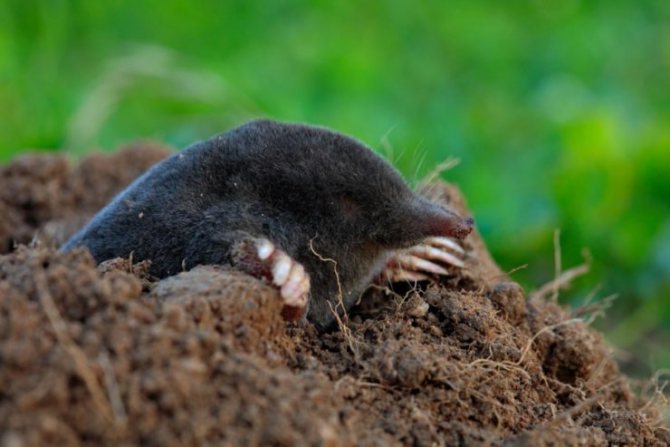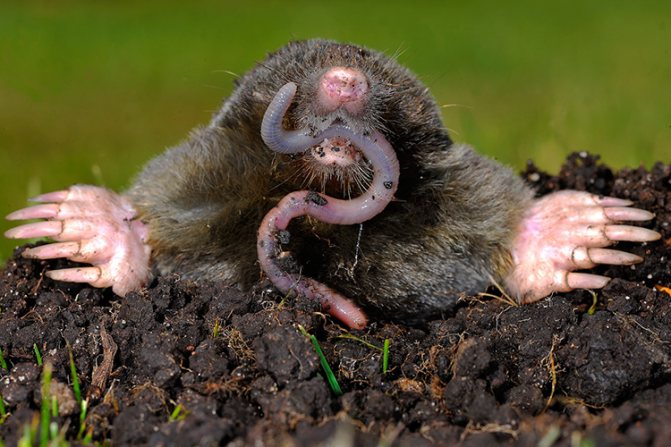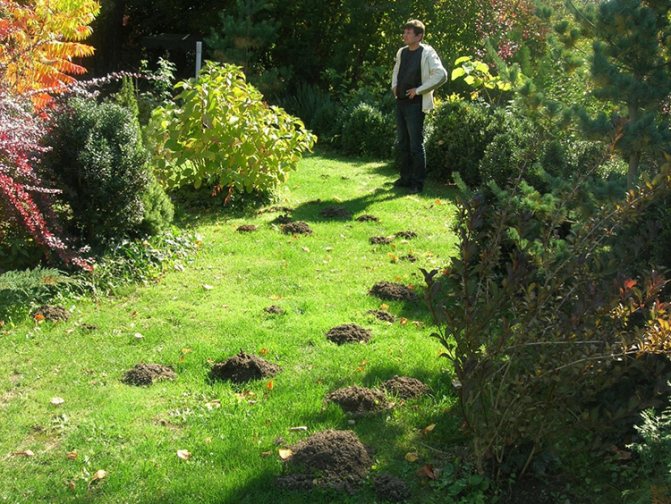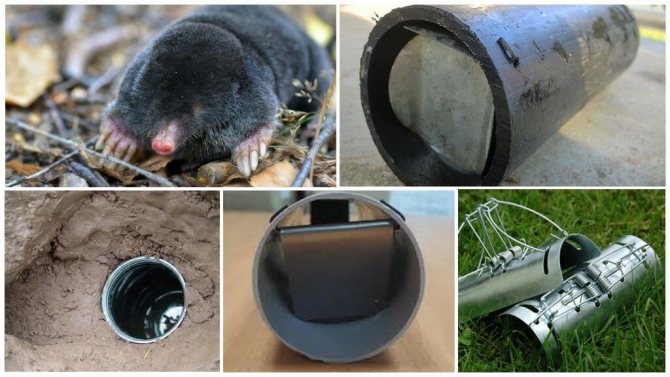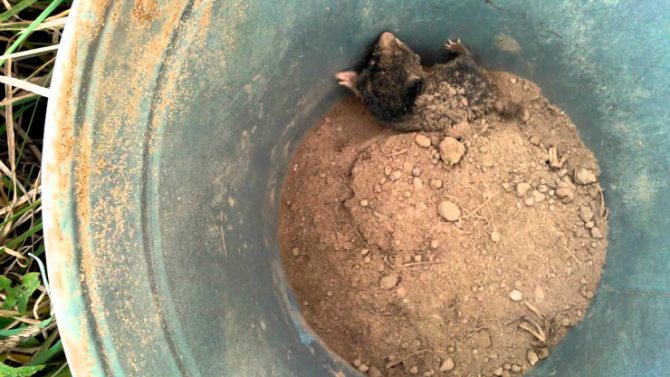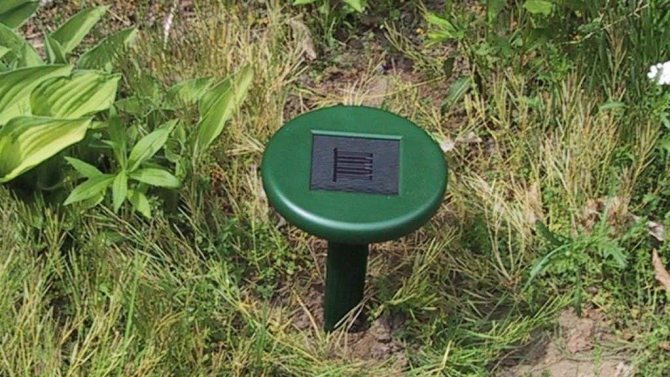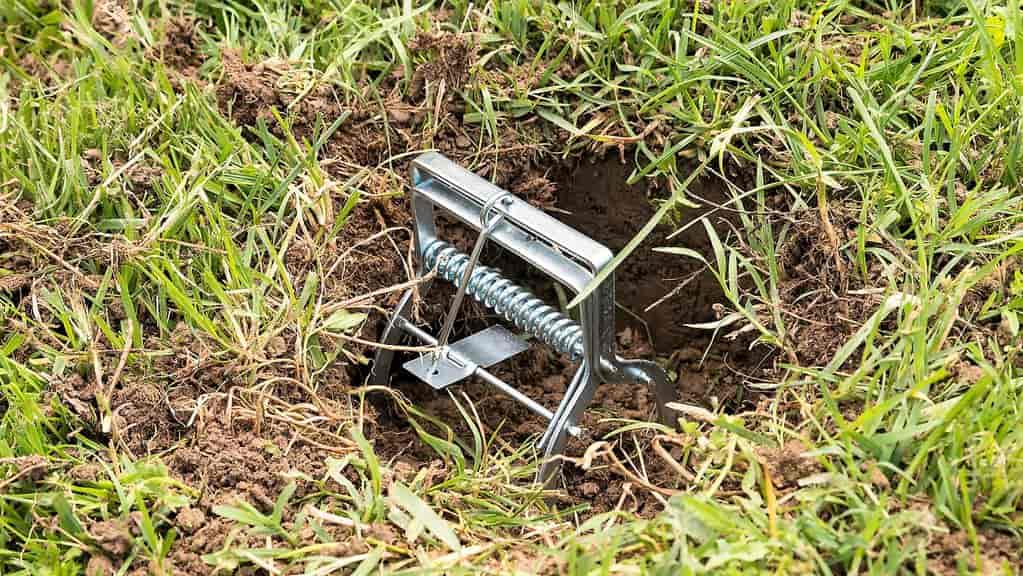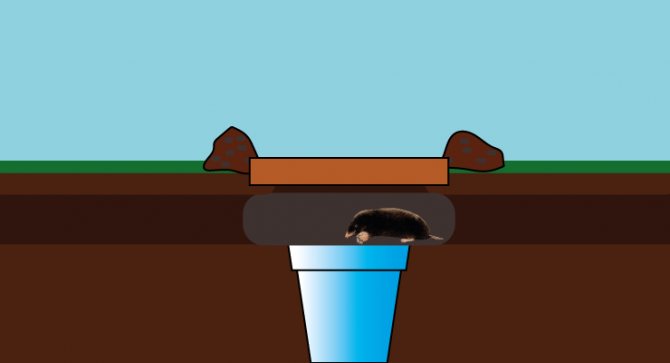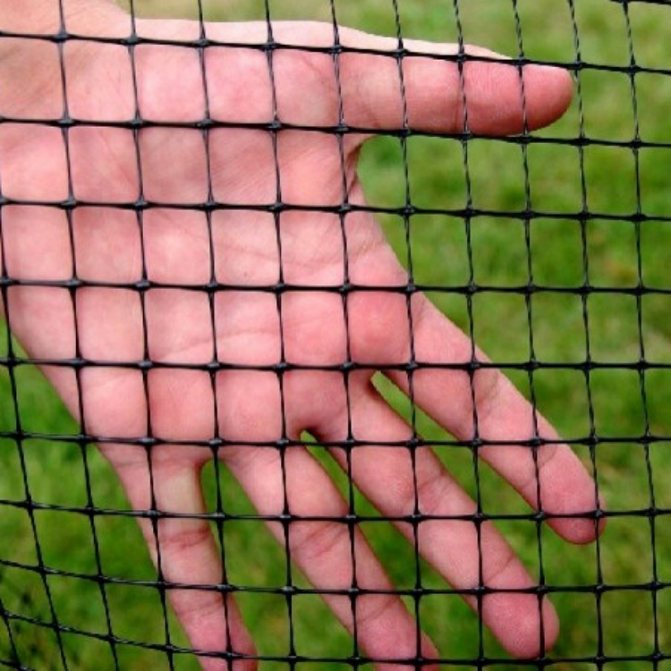If you suddenly find strange holes in your area, this is a bad sign. It means that moles have occupied your territory. It would seem, what harm can these cute underground inhabitants do? People who are constantly attacked by moles are unlikely to agree with such a philistine opinion. Many gardeners and summer residents are concerned about the questions: how to get rid of moles on the site, how can this affect the harvest? The editors of the Agronom.guru portal, as always, offer proven recommendations with comprehensive answers to all your questions.
If you have tried all conceivable and inconceivable ways of dealing with uninvited guests and it does not help, then this article is just for you.
Is the mole a pest or not?
Moles dig their feeding and passage tunnels at a depth of about 50-70 cm.The tunnels in which they live and where they produce offspring lie at a depth of about 2 m.

In addition, animals are "family", and if you notice moles on the site, then know that we are not talking about one individual, but about his family. Fortunately, the animals are very zealous in defending their territory, so the second family will not live on the same piece of land.
Seen from one side, this is a small animal brings considerable benefit favorite site:
- It actively loosens the soil at a depth of 50-70 cm, which leads to its active aeration;
- Due to the fact that moles are constantly moving through their underground tunnels, digging new passages, the soil is swollen, which improves its quality;
- The most important reason moles appear in the country is prey. Their main diet consists of earthworms, bears and other insects, which are much more abundant in fertile, well-groomed, constantly irrigated soils. Thus, moles rid us of other no less annoying pests. The same annoying mice and voles are also part of their diet.
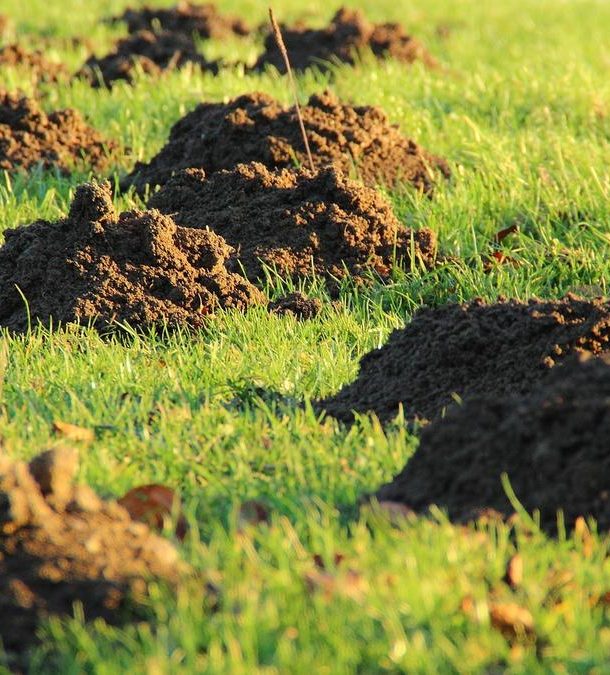

On the other hand, the high activity of moles is due to the appearance of numerous earthen mounds, which spoil the appearance of the site. Paving new passages, the mole literally rams everything in its path thanks to its unusually strong front limbs with long curved claws. Under the rhizomes of plants, voids are formed and soon the roots, deprived of nutrition, begin to dry out and wither. In this case, you can forget about the harvest. Therefore, there should still be no moles on the site. There are several ways to resolve the issue of their expulsion. We will begin our review with humane methods, because despite sabotage, we are talking about living things.
Extreme measures
Pets will also help in catching moles. Dogs and cats, running around the site, often break up wormholes under the influence of the hunting instinct. To cats, animals resemble mice, so they become desirable prey. However, in this case, if the animals do not die, then they receive serious injuries.
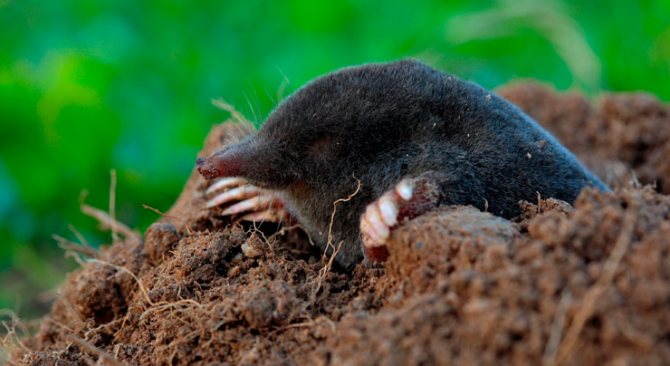

It is important to understand that moles are just animals, they do not intentionally harm, so try to resort to humane methods, if possible.
Other inhumane, but quite reliable methods include traps and mole-swabs of various models, which are sold in many stores in stores. They are equipped with a spring and are aimed at directly killing the animal that falls into the trap.
In general, the question of how to catch a mole that has appeared on the site is solved quite simply.Sometimes the fight against animals takes a lot of time, but thanks to humane methods, it is possible to protect the crop, and at the same time not harm the animals.
It is interesting: Mole repeller which is better.
Noise methods
As you know, moles have very poor eyesight, but the sense of smell and hearing are heightened. Using this knowledge, you can try to get rid of pests by increasing the noise level.


Moles will begin to be annoyed by such a situation and they will rush to find a quieter habitat. Noise repellents
you can do it yourself from improvised means:
- Take ordinary glass bottles, preferably a larger volume. Champagne bottles are ideal. The bottle must be dug into the ground at an angle of 45 ° for about 2-3 of its length. The essence of the method lies in the fact that the wind, falling into an empty neck, will begin to emit humming sounds and a small vibration, which will be a deterrent factor;
- Some summer residents advise using reed stalks for homemade noisemakers. It is necessary to choose stems at least 1.5-2 meters long. Their core is thoroughly cleaned, and then several stems are driven into the ground to a great depth so that only 50-70 cm of the remaining length protrudes above the soil. When the wind blows, the reeds will vibrate, and the vibration will be transmitted along the entire length of the stems deep into the ground. Some people insert pancake wire into the hollow interior of the reed to enhance the effect;


- To make the next device, we need a plastic bottle and a piece of fittings or a metal pipe of a small diameter about 2 m long. The fittings must be driven into the ground to a depth of 50 cm. Next, you need to cut the bottle. Without cutting off the bottom, cut four petals in the cylindrical part with a small distance between the elements and bend them. You will get an impromptu windmill. The bottle is put on the pin with the neck down so that the top of the pin rests against the bottom. During the wind, the blades will spin the bottle, and due to the high height, the vibrations transmitted to the armature will be well felt by the moles;
- By analogy with the previous method, you can make a noisemaker from a can of a drink or canned food. The can is simply put on an iron stake and rumbles loudly.
It should be noted right away that such self-made devices have a very small radius of action. Sound and vibration will propagate only a couple of meters, and it is highly likely that the animal will simply go around the epicenter and make its way elsewhere. Therefore, either you will have to use a large number of noisemakers, or use them as preventive measures, installing them around the perimeter of the site. This is especially true if not you, but your neighbors, entered the fight against the moles. Poor animals will have to run somewhere. And where, if not to the neighboring site?
Another unpleasant side such a method will be the fact that the constant noise and clanging of a tin can against iron reinforcement can infuriate not only the moles, but also the owner of the dacha.
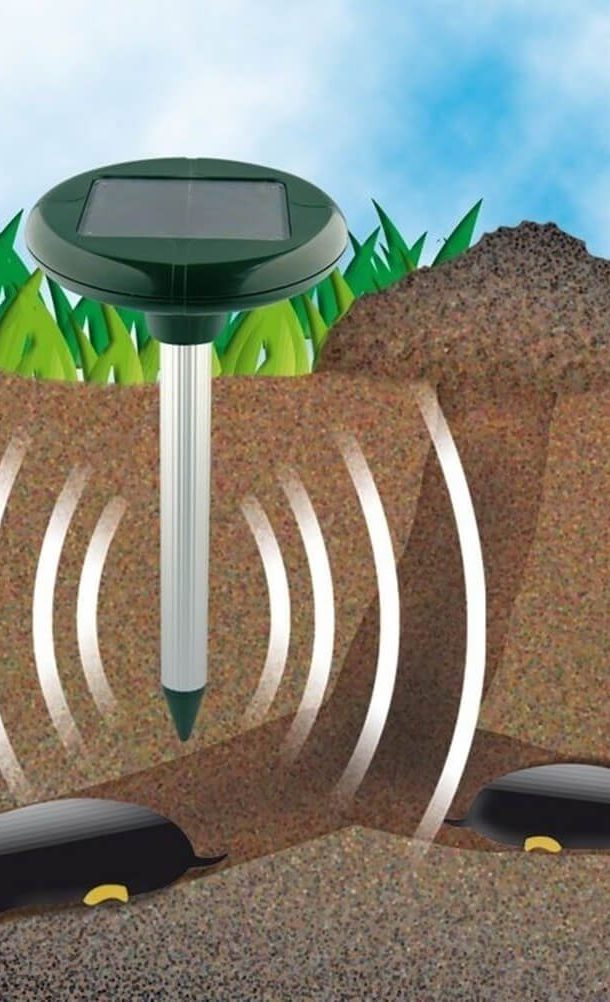

Pay attention to the store
"Mole scarers". The principle of operation of these small devices is based on the continuous reproduction of ultrasonic pulses, which form low-frequency vibrations. The human body does not in any way perceive such vibration and sound, but on moles, such an effect has an irritating effect, which leads to indigestion. Moles will rush to leave such an uncomfortable area soon. We can say that this is the most effective of the humane methods of struggle.
Shrews: what do they look like, why do they appear in the country, what is the threat of their invasion?


Shrews are small insectivores, similar in appearance to mice with an elongated snout like a proboscis.They live in empty stumps and trunks of fallen trees, they can also settle in burrows and tunnels of moles. They feed on various insects and their larvae. These are voracious animals with an increased metabolism, therefore, adults eat such an amount of food that exceeds their own weight by 2 times.
Shrews are attracted by garden plots densely populated with insect larvae. These animals treat and clean their backyard, however, in search of food, the shrews loosen the soil with the help of the nose-trunk and thereby destroy the plantings. The invasion of shrews in the garden threatens to damage the beds and flower beds.
Anti-mole odors
Some methods of dealing with moles are based on irritating their sense of smell. Bulbs some types plants have a rather specific odor, unpleasant for animals.


These include garlic, beans, imperial hazel grouse, cannabis, daffodils, marigolds, woodland. That is, if your site is occupied by small diggers, then you need to plant the entire territory with one of the selected plants. Why do we say the whole territory - because in many forums summer residents note that the animals simply bypassed the flower beds with daffodils or beds with legumes, but did not leave the site. If you have just purchased your summer cottage, perhaps planting the land with daffodils is not a bad idea, otherwise this the method works ineffectively. Other aromas are also used:
- Kerosene, fuel oil, antifreeze. A cloth soaked in a kerosene solution is placed in a mole and dripped in. The solution is prepared at the rate of 100 ml of kerosene per bucket of water. Fuel oil or antifreeze is simply applied to rags;
- Naphthalene. The powder is poured directly into the mole and covered with earth;
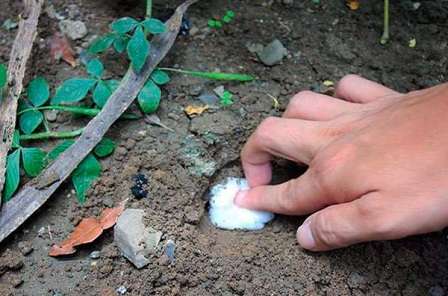

- The site is irrigated with a solution based on castor oil. 200 ml of oil is poured into a bucket of water and 2 tbsp. spoons of any detergent, mix thoroughly and distribute over the territory. This is best done after rain or watering;
- Strong-smelling herbs can be used - sagebrush or mint. Bunches of grasses are distributed in mole holes and change as they wilt;
- Raw fish heads, rotten eggs or rotten fruits / vegetables are laid out in mole holes and buried. During rotting, food will give off an unpleasant odor, which should scare away moles.
Minus given method obvious - a foul-smelling rotting fish, a pungent smell of kerosene or antifreeze will scare away not only moles, but also people from the site. In addition, the method will only be effective if the active substance is regularly changed as the pungent odor evaporates. Otherwise, the animals will return quickly. And it will take a long time and painfully to smoke the unfortunate moles with this method.
On sale already ready-made biological products, the so-called "flavorings". These are small balls that need to be distributed throughout the area according to the instructions.
Traps
It will be about homemade traps and methods of catching moles with the aim of their further release as far as possible from your site.
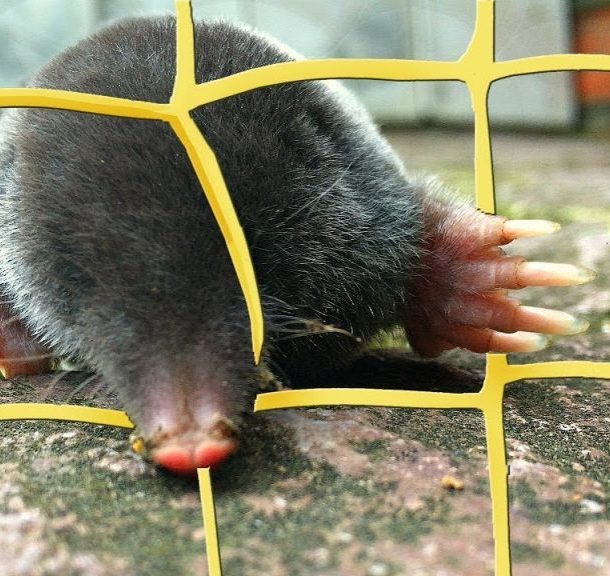

It is very important not to release the animal near the territory, otherwise it will return very quickly.
- The essence of the first method - catch a mole while it is moving. You will need a shovel and a lot of patience. It is best to go hunting in the morning or evening, when the mole prowls through the tunnels in search of food. Watch the mole moles closely. If you see movement, noticeable by the swelling of the soil, you need to very quickly stick the shovel behind the mole and quickly throw it along with the ground to the surface. The shovel must be stuck exactly behind the animal, and not in front of it, otherwise this method will no longer be humane. Pay attention to who the mole has very strong limbs and sharp claws, so you should not catch it later with your hands without gloves;
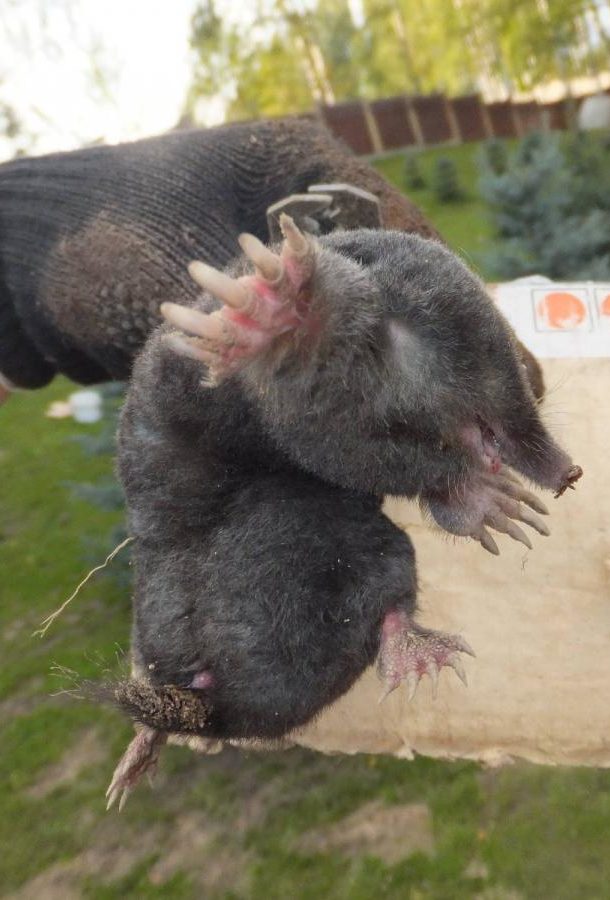

- The next method is capture mole in pan or empty jar. The mole must be excavated, perpendicular to the tunnel, make a depression in the ground and install a jar in it so that its neck is level with the tunnel in height. After installing the can, you need to restore the tunnel - you can use a sheet of cardboard. It is installed in such a way that it covers the tunnel, after which it is sprinkled with earth. A mole, passing through the tunnel, will certainly fall into the jar and will not be able to get out along its smooth walls. It is best to use three-liter jars. But in order to understand whether the fishing ended in luck, you will need to constantly unearth the trap and check its contents;
- Homemade trap out plastic bottles. For its manufacture, an ordinary bottle with a volume of 1 or 1.5 liters is taken, the bottom and throat are cut off so that only a flat cylindrical part remains. Do not discard the neck part. It needs to be cut into strips no more than 1 cm wide so that they open like petals on a flower. You will need two such parts. They need to be inserted from both ends of the plastic pipe with the throat inward so that the folded strips are folded inward. The mole will be able to crawl into the neck of the bottle, but will not be able to get out back due to the fact that it will bump into the bent plastic rays;
- Mole catchers. You can make it yourself from thick wire according to the sketch shown in the image, or buy ready-made ones. They don't kill the animal. But they can be ineffective if the mole approaches her from the wrong side. Freeing the animal from the trap, you need to take it by the withers, in this position it will not be able to bite you;
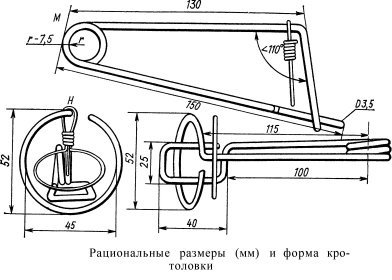

- Another way to catch moles is to fill their moves. water. This will not incur large costs if water comes to the site from the nearest reservoir. Otherwise, a large amount of it may be required to flood the tunnels, since the total duration of the underground passages can reach about 200 meters. During flooding, animals either begin to crawl to the surface, then you need to react quickly, because it is imperative to catch a mole. Or they cannot get out and drown;


- Some summer residents say that they managed not only to expel moles from the site, but also to prevent their re-invasion with the help of pets, namely cats. In rare cases, dogs. Some cats do not show any activity at the sight of small nimble animals, but if yours is a real hunter, it is worth trying. Having noticed a mole on the surface once, the cat will know that there is prey underground and will hunt continuously.
Ready-made ultrasonic scarers


Ultrasonic scarers of moles from the garden Special ultrasonic devices are also based on the principle of acoustic scaring, which are produced industrially, both Russian and foreign. They use ultrasonic waves that are inaudible to the human ear.
Installation on the site of acoustic devices Antikrot, Krotogon, EcoSniper, Cityitek, etc., which generate ultrasonic signals that notify the animals of danger, will force the "underground guests" to leave the territory of the garden.
The disadvantage of this method is the rather expensive equipment and the effect of ultrasound signals on pets, as well as the short-term action, because after turning off the device, all moles can return back.
Poisons
Unfortunately, many summer residents, who resorted to both imaginable and inconceivable methods in the fight against moles, note that the most effective way to get rid of them is to use poisons. It is necessary to use poisons very carefully and is not recommended if domestic animals live on the site.
- there is special poisons, designed to combat moles.They process earthworms, which are then placed in mole holes and buried;
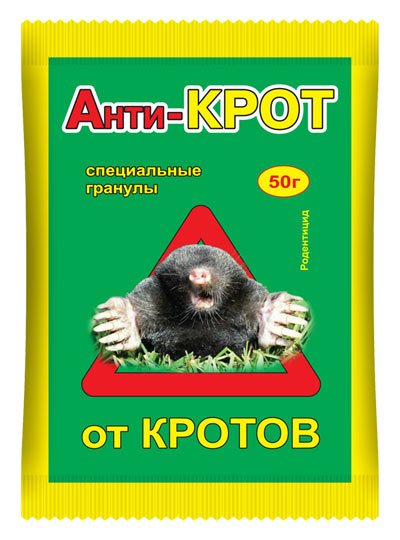

- The cruelest is the use of special smoke bombs, which generate a large amount of pungent smoke even underground, where a minimum amount of oxygen enters. Moles begin to run away from the smoke deep into the tunnel, where they eventually suffocate from the suffocating gas.
Common mistakes
There is an opinion that a family of moles can be driven out of the site using products with a pungent smell, placed in different places of land. This is a mistake, small diggers sprinkle soil on the side from where the bad smell comes from.
Another common mistake is using noise scares. Completely useless stuff. Moles happily settle near highways and railways.


Prophylaxis
After the fight against moles is crowned with victory, it is worth thinking about how to protect your possessions from re-invasion.
- Alternatively, you can plant one of the above plants around the perimeter of the site, the smell of which scares off moles;


- Summer residents, whose struggle was hard and exhausting, do not want to rely on chance and take radical measures - they install along the perimeter of their site protective barrier. To do this, a trench is dug into which a fine-mesh metal mesh is installed in a vertical position and backfilled with earth. The mole rests against an obstacle and automatically changes direction. True, you will have to dig quite deep. At least below the level of soil freezing - 1.2-1.5 m, depending on the region. The general belief that moles sleep in winter is a fallacy. It's just that their activity is somewhat reduced, and the depth of making moves becomes greater. Just imagine how laborious this method is. And the metal, under the influence of moisture and minerals in the soil, over time will begin to corrode and collapse.
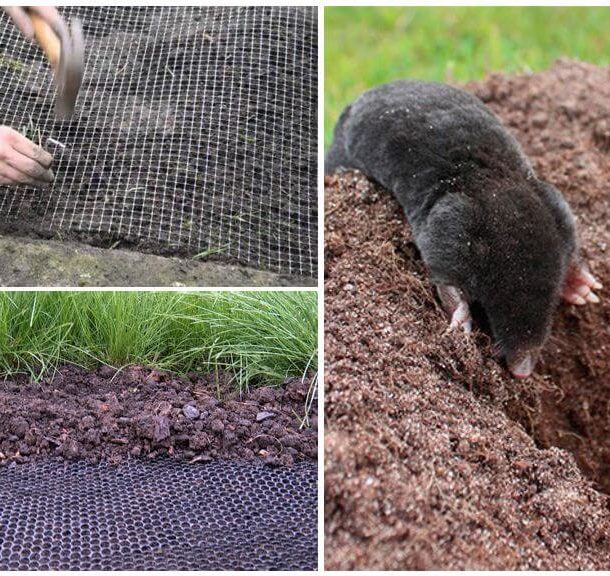

Therefore, if you notice molehills in neighboring plots, immediately purchase and install purchased repellents at your dacha.
Tags: Improvement of the territory, cottage
We put a trap
A mole trap is a type of trap that is set in a hole and triggered when touched. Now in stores you can find various variations of mole traps. I recommend the wire loop. It fits perfectly into the burrow and is easy to set up. Works almost flawlessly. The appearance is shown below in the picture.
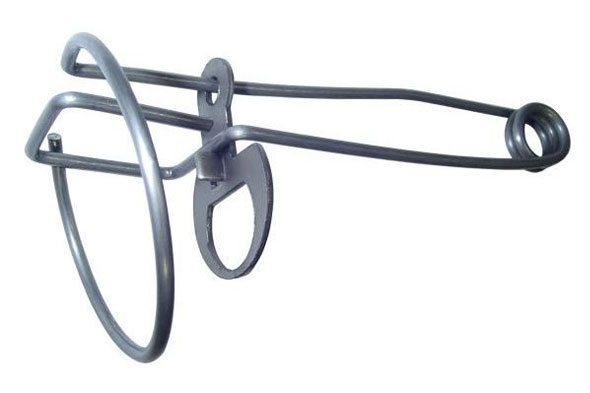

The principle of operation is similar to a mousetrap, only there is no need for bait.
Installation rules:
- The trap cannot be taken with bare hands. Ideally, treat it with odorless oil and install it with gloves so that the mole does not suspect an ambush, smelling the smell of a person in the hole.
- 2 mole traps are placed in one hole. One for each direction. With the watchful side, we insert it into the course.
- Install into the tunnel, first breaking it. You need to get access to a hole as long as a mole trap.
- It is advisable to insert a nail into the ring of each spring - the two hundred will be just right. Nails should also not be picked up with bare hands.
- After installation, we cover it with earth without tamping.
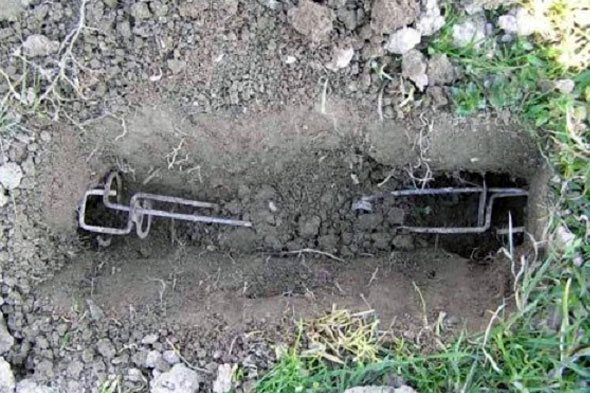

Without fixing the mole trap in the burrow with a nail or wire, the next day it may not be found on the spot.
In most cases, by setting a trap in the evening, you can collect the first trophies in the morning. However, much depends on the activity of the mole and the time of year. This is best caught in the fall, on the eve of the first frost.


